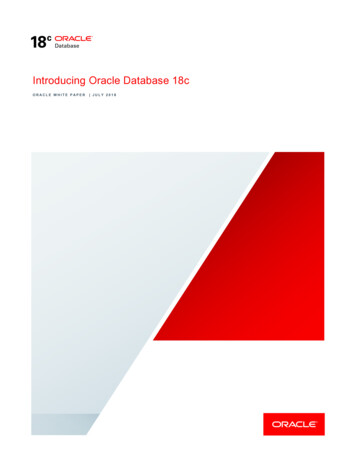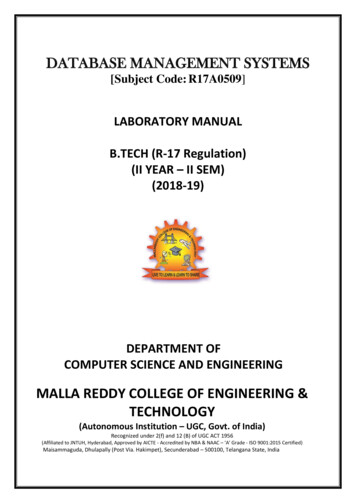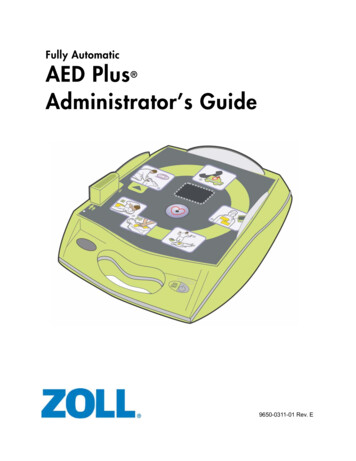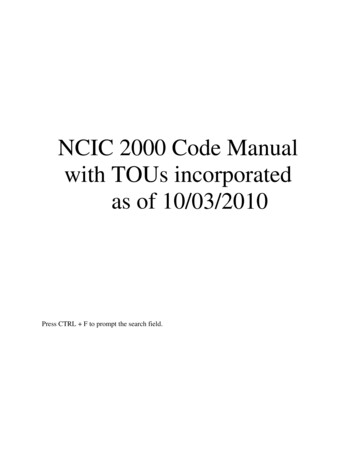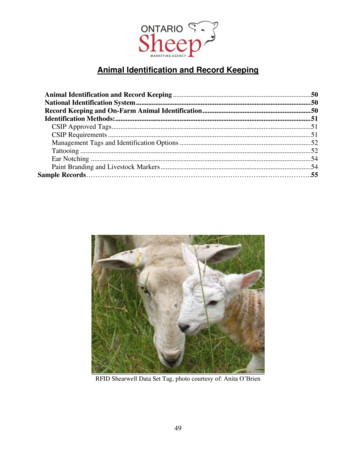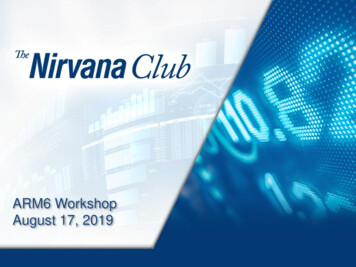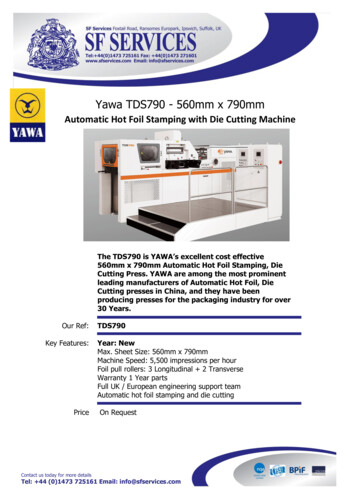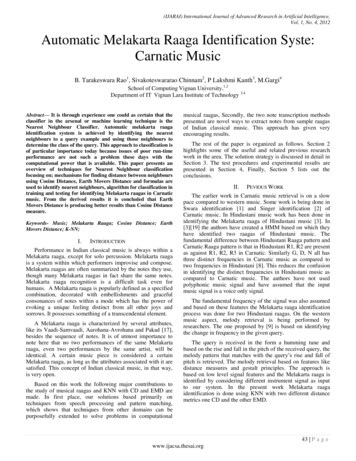
Transcription
(IJARAI) International Journal of Advanced Research in Artificial Intelligence,Vol. 1, No. 4, 2012Automatic Melakarta Raaga Identification Syste:Carnatic MusicB. Tarakeswara Rao1, Sivakoteswararao Chinnam2, P Lakshmi Kanth3, M.Gargi4School of Computing Vignan University,1,2Department of IT Vignan Lara Institute of Technology 3,4Abstract— It is through experience one could as certain that theclassifier in the arsenal or machine learning technique is theNearest Neighbour Classifier. Automatic melakarta raagaidentification system is achieved by identifying the nearestneighbours to a query example and using those neighbours todetermine the class of the query. This approach to classification isof particular importance today because issues of poor run-timeperformance are not such a problem these days with thecomputational power that is available. This paper presents anoverview of techniques for Nearest Neighbour classificationfocusing on; mechanisms for finding distance between neighboursusing Cosine Distance, Earth Movers Distance and formulas areused to identify nearest neighbours, algorithm for classification intraining and testing for identifying Melakarta raagas in Carnaticmusic. From the derived results it is concluded that EarthMovers Distance is producing better results than Cosine Distancemeasure.Keywords- Music; Melakarta Raaga; Cosine Distance; EarthMovers Distance; K-NN;I.INTRODUCTIONPerformance in Indian classical music is always within aMelakarta raaga, except for solo percussion. Melakarta raagais a system within which performers improvise and compose.Melakarta raagas are often summarized by the notes they use,though many Melakarta raagas in fact share the same notes.Melakarta raaga recognition is a difficult task even forhumans. A Melakarta raaga is popularly defined as a specifiedcombination, decorated with embellishments and gracefulconsonances of notes within a mode which has the power ofevoking a unique feeling distinct from all other joys andsorrows. It possesses something of a transcendental element.A Melakarta raaga is characterized by several attributes,like its Vaadi-Samvaadi, Aarohana-Avrohana and Pakad [17],besides the sequence of notes. It is of utmost importance tonote here that no two performances of the same Melakartaraaga, even two performances by the same artist, will beidentical. A certain music piece is considered a certainMelakarta raaga, as long as the attributes associated with it aresatisfied. This concept of Indian classical music, in that way,is very open.Based on this work the following major contributions tothe study of musical raagas and KNN with CD and EMD aremade. In first place, our solutions based primarily ontechniques from speech processing and pattern matching,which shows that techniques from other domains can bepurposefully extended to solve problems in computationalmusical raagas, Secondly, the two note transcription methodspresented are novel ways to extract notes from sample raagasof Indian classical music. This approach has given veryencouraging results.The rest of the paper is organized as follows. Section 2highlights some of the useful and related previous researchwork in the area. The solution strategy is discussed in detail inSection 3. The test procedures and experimental results arepresented in Section 4, Finally, Section 5 lists out theconclusions.II.PEVIOUS WORKThe earlier work in Carnatic music retrieval is on a slowpace compared to western music. Some work is being done inSwara identification [1] and Singer identification [2] ofCarnatic music. In Hindustani music work has been done inidentifying the Melakarta raaga of Hindustani music [3]. In[3][19] the authors have created a HMM based on which theyhave identified two raagas of Hindustani music. Thefundamental difference between Hindustani Raaga pattern andCarnatic Raaga pattern is that in Hindustani R1, R2 are presentas against R1, R2, R3 in Carnatic. Similarly G, D, N all hasthree distinct frequencies in Carnatic music as compared totwo frequencies in Hindustani [8]. This reduces the confusionin identifying the distinct frequencies in Hindustani music ascompared to Carnatic music. The authors have not usedpolyphonic music signal and have assumed that the inputmusic signal is a voice only signal.The fundamental frequency of the signal was also assumedand based on these features the Melakarta raaga identificationprocess was done for two Hindustani raagas. On the westernmusic aspect, melody retrieval is being performed byresearchers. The one proposed by [9] is based on identifyingthe change in frequency in the given query.The query is received in the form a humming tune andbased on the rise and fall in the pitch of the received query, themelody pattern that matches with the query’s rise and fall ofpitch is retrieved. The melody retrieval based on features likedistance measures and gestalt principles. The approach isbased on low level signal features and the Melakarta raaga isidentified by considering different instrument signal as inputto our system. In the present work Melakarta raagaidentification is done using KNN with two different distancemetrics one CD and the other EMD.43 P a g ewww.ijacsa.thesai.org
(IJARAI) International Journal of Advanced Research in Artificial Intelligence,Vol. 1, No. 4, 2012III.PRESENT WORKK Nearest Neighbour has rapidly become one of thebooming technologies in today’s world for developingconvoluted control systems. Melakarta raaga Recognition isthe fascinating applications of KNN – which is basically usedin Melakarta raaga identification for many cases, Melakartaraaga detection is considered as a rudimentary nearestneighbour problem. The problem becomes more fascinatingbecause the content is an audio – given an audio find the audioclosest to the query from the trained database.The intuition underlying Nearest Neighbour Classificationis quite straight forward, classified based on the class of theirnearest neighbours. It is often useful to take more than oneneighbour into account so the technique is more commonlyreferred to as k-Nearest Neighbour (k-NN) Classificationwhere k nearest neighbours are used in determining the class.Since the training examples are needed at run-time, i.e. theyneed to be in memory at run-time, it is sometimes also calledMemory-Based Classification. Because induction is delayed torun time, it is considered a Lazy Learning technique. Becauseclassification is based directly on the training examples it isalso called Example-Based Classification or Case-BasedClassification.The basic idea is as shown in Figure 1 which depicts a 3Nearest Neighbour Classifier on a two-class problem in a twodimensional feature space. In this example the decision for q 1is straightforward – all three of its nearest neighbours are ofclass O so it is classified as an O. The situation for q 2 is a bitmore complicated at it has two neighbours of class X and oneof class O. This can be resolved by simple majority voting orby distance weighted voting (see below). So k NNclassification has two stages; the first is the determination ofthe nearest neighbours and the second is the determination ofthe class using those neighbours. The following sectiondescribes the techniques CD and EMD which is used to raagaclassification.Cosine similarity has a special property that makes itsuitable for metric learning: the resulting similarity measure isalways within the range of -1 and 1. This property allows theobjective function to be simple and effective.B. EARTH MOVER DISTANCE (EMD)The Earth Mover Distance is based on the solution to adiscrete optimal mass transportation problem. EMD representsthe minimum cost of moving earth from some source locationsto fill up holes at some sink locations. In other words, givenany two mass (or probability) distributions, one of them can beviewed as a distribution of earth and the other a distribution ofholes, then the EMD between the two distributions is theminimum cost of rearranging the mass in one distribution toobtain the other. In the continuous setting, this problem isknown as the Monge-Kantorovich optimal mass transferproblem and has been well studied over the past 100 years theimportance here is that EMD can be used to measure thediscrepancy between two multidimensional distributions.C. METHODOLOGY/ALGORITHM FOR MELAKARTARAAGA RECOGNITION SYSTEMFollowing is the methodology is used for the Melakartaraaga Recognition for training and testing. Initially first kNearest Neighbour Classifier is determined on a two-classproblem in a two-dimensional feature space which is shown inthe following diagram raagas in horizontal axis andneighbours of raaga on the vertical axis. In this proposedapproach the decision for raaga is straightforward – one of itsnearest neighbours is of class O and one of class X.Fig. 2 1-Nearest Neighbour classification of RaagasFig. 1 A simple example of 3-Nearest Neighbour ClassificationA. COSINE DISTANCECosine similarity (CD) between two vectors x and y is defined as:A training dataset D is made up of (xi), I Є[1, D ] trainingsamples where xi is the raaga. The raaga is divided in to 15samples by eliminating unwanted frequencies (disturbances,accompanied instruments) by using low level filter-FourierTransform of a Signal (Spft). The same process is repeated foreach raaga in database D. Then these samples are trained byusing Self- Organizing and Learning Vector QuantizationNets. The grouping process is carried by us. Each trainingexample is labeled with a class label yj Є Y. Our objective isto classify an unknown example raaga q. Now training processis completed. Next the testing phase is performed by usingKNN classification.The KNN approach carried in two phasesCD(x; y) (xT * y)/( x * y ) ------- (1)44 P a g ewww.ijacsa.thesai.org
(IJARAI) International Journal of Advanced Research in Artificial Intelligence,Vol. 1, No. 4, 20121 Determination of Nearest Neighbours2 Determination of the class using those neighboursvector-space model. The cosine is calculated by using thefollowing formula DETERMINATION OF NEAREST NEIGHBOURS : For each xi Є D the distance between q and xi is calculatedas follows: d ( q, x i ) f Ff ( q f , xi f )------(2)Where xi trained raaga ,q testing raaga,f feature(flow pattern)wf weighted feature of raagaThere are huge ranges of possibilities for this distancemetric; a basic version for continuous and discrete attributeswould be: 0f discrete and q f xi f (q f , xi f ) 1f discrete and q f xi f q x f continuousif f----(3)The k nearest neighbours is selected based on this distancemetric. In order to determine the class of q the majority classamong the nearest neighbours is assigned to the query. It willoften make sense to assign more weight to the nearerneighbours in deciding the class of the query.DETERMINATION OF THE CLASS USING THOSE NEIGHBOURS:If more than one of the neighbours is identified then it canbe resolved by simple majority voting or by distance weightedvoting. A fairly general technique to achieve this is distanceweighted voting where the neighbours get to vote on the classof the query case with votes weighted by the inverse of theirdistance to the query.----- (5) 2) EARTH MOVER DISTANCEThe Earth Mover Distance (EMD) is a distance measurethat overcomes many of problems that arise from thearbitrariness of binning. As the name implies, the distance isbased on the notion of the amount of effort required to convertone instrumental music to another based on the analogy oftransporting mass from one distribution to another. If twoinstrumental music are viewed as distributions and view onedistribution as a mass of earth in space and the otherdistribution as a hole (or set of holes) in the same space thenthe EMD is the minimum amount of work involved in fillingthe holes with the earth. Some researchers analysis of theEMD argue that a measure based on the notion of a signatureis better than one based on a histogram. A signature {sj mj,wmj } is a set of j clusters where mj is a vector describing themode of cluster j and wmj is the fraction of features fallinginto that cluster.Thus, a signature is a generalization of the notion of ahistogram where boundaries and the number of partitions arenot set in advance; instead j should be ‘appropriate’ to thecomplexity of the instrumental music. The example in Figure3 illustrates this idea. The clustering can be thought as aquantization of the instrumental music in some frequencyspace so that the instrumental music is represented by a set ofcluster modes and their weights. In the figure the sourceinstrumental music is represented in a 2D space as two pointsof weights 0.6 and 0.4; the target instrumental music isrepresented by three points with weights 0.5, 0.3 and 0.2. Inthis example the EMD is calculated to be the sum of theamounts moved (0.2, 0.2, 0.1 and 0.5) multiplied by thedistances they are moved. Calculating the EMD involvesdiscovering an assignment that minimizes this amount.k11( y j , y c )nc 1 d (q, xc )Vote ( yi ) ------ (4)Thus the vote assigned to class yj by neighbour xc is 1divided by the distance to that neighbour, i.e. 1(yj , yc) returns1 if the class labels match and 0 otherwise. From the aboveequation would normally be 1 but values greater than 1 can beused to further reduce the influence of more distantneighbours. Now the distance measures Cosine and EMDmeasures applied to our KNN process is discussed.Fig. 3. An example of the EMD between two 2D signatures with two points(clusters) in one signature and three in the other.For two instrumental music described by signatures S {mj ,wmj }nj 1 and Q {p k,wpk}r k 1 . The work required totransfer from one to the other for a given flow pattern F:1) COSINE DISTANCE MEASUREThe cosine similarity measure is the cosine of the anglebetween these two vectors, suppose di and dj are the pathsbetween ai and aj in instance xi and instance xj, respectively. diand dj are represented as vectors of term frequencies in thenrWORK ( S , Q, F ) d jk f i kj 1 k 1---- (6)45 P a g ewww.ijacsa.thesai.org
(IJARAI) International Journal of Advanced Research in Artificial Intelligence,Vol. 1, No. 4, 2012where djk is the distance between clusters mj and pk and fjkis the flow between mj and pk that minimizes overall cost.Once the transportation problem of identifying the flow thatminimizes effort is solved by using dynamic programming.The EMD is defined as:0.60.4 j 1 k 1 d jk f j knE M D ( S , Q) 0.80.2r nrj 1k0f jk-0.2-----(7)-0.4EMD is expensive to compute with cost increasing morethan linearly with the number of clusters. Nevertheless it is aneffective measure for capturing similarity betweeninstrumental music. It is identified that the EMD approach isgiving better results than Cosine measure.-0.6-0.800.511.522.533.546x 10Fig. 5 Plot Graph for Kharaharapriya RaagaRESULTS AND DISCUSSIONThe input signal is sampled at 44.1 KHz. The identificationof different Raagams for the purpose of evaluating thisalgorithm is considered. For the purpose of Melakarta raagaidentification seven different instruments are considered. Thesignal is made to pass through the signal separation algorithm,and segmentation algorithm.The result showing the segmentation points for one input isshown in below Figures. This is the first level of segmentationwhere the protruding lines indicate the points of segmentation.After identifying the segmentation points the frequencycomponents are determined using the HPS algorithm andtabulated the frequency values which have the dominantenergy. Using the raaga identification system, the confusionmatrix is determined.Song & Detected Edges10.8Amplitude / e (s)The following figure shows the plot graphs and edgedetection graphs:Fig. 6 Bhiravi raaga for Edge detectionSong .8-0.5-100.511.522.533.5046x 1020406080100Time (s)Fig. 7 Bhiravi raaga for Song FilteredFig.4 Plot Graph for Begada Raaga46 P a g ewww.ijacsa.thesai.org
(IJARAI) International Journal of Advanced Research in Artificial Intelligence,Vol. 1, No. 4, 2012Cosine Distance: The Data is different for Train andSampleSong & Detected Edges1Amplitude / Edge0.8Table 2 Confusion Matrix: Different data for Train and Sample0.6Recognized Raagas (%)0.4Name bherithe 030405060708090Time (s)Fig. 8 Malahari raaga for Edge detectionSong FilteredAmplitude10.5The following are the results obtained by applying EMDDistance measureEMD: The Data is same for both Train and Sample0Table 3 Confusion Matrix: Same data for Train and SampleRecognized Raagas (%)-0.501020304050607080Name of90Time (s)the RaagaFig. 9 Malahari raaga for Song om6674728696BegadaThe following are the results obtained by applying CosineDistance measureVanasapatCosine Distance: The Data is same for Train and SamplehisundavinoTable 1 Confusion Matrix: Same data for Train and SampleName ofthe RaagaBegadaVanasapathisundavinodiniRecognized Raagas 660655892637072diniEMD: The Data is different for Train and SampleTable 4 Confusion Matrix: Different data for Train and SampleRecognized Raagas (%)Name ndilom626547 P a g ewww.ijacsa.thesai.org
(IJARAI) International Journal of Advanced Research in Artificial Intelligence,Vol. 1, No. 4, .CONCLUSIONK-NN is very simple to understand and easy to implement.So it should be considered in seeking a solution to anyclassification problem. In some circumstances where anexplanation of the output of the classifier is useful, K-NN canbe very effective if an analysis of the neighbours is useful asexplanation. In order to improve classification process anEMD approach is used for fast convergence. K-NN is verysensitive to irrelevant or redundant features because allfeatures contribute to the similarity and thus to theclassification. This can be ameliorated by EMD approach andfeature selection or feature weighted voting. The EMD resultsare compared with Cosine distance measure and observed thatEMD gives better 4].[15].[16].Rajeswari Sridhar, Geetha T. V, “Swara Indentification for South IndianClassical Music”, ICIT '06 Proceedings of the 9th InternationalConference on Information Technology, IEEE Computer Society,ISBN:0-7695-2635-7.Youngmoo E. Kim, Brian Whitman” Singer Identification in citeseerx.ist.psu.edu/viewdoc/download?doi 10.1.1.115.Paul G., Corine G.M., Christophe C., Vincent F. “automaticclassification of environmental noise events by hidden Markov oi 10.1.1.52Berger. “Some factors in the recognition of timbre“. J. Audio. Eng. Soc.30, pp. 396-406.[17].[18].[19].Clark, Milner. “Dependence of timbre on the tonal loudness produced bymusical instruments“. J. Audio. Eng. Soc. 12, pp. 28-31.Eagleson, H. W., Eagleson, O. W. “Identification of musical instrumentswhen heard directly and over a public-address system“. J. Acoust. Soc.Am. 19, pp. 338-342.Strong, Clark. “Perturbations of synthetic orchestral wind instrumenttones“. J. Acoust. Soc. Am., Vol. 41, pp. 277-285.Bhatkande.V (1934), Hindusthani Sangeet Paddhati.Sangeet Karyalaya,1934.Schroeder.M.R (1968), ” Period histogram and product spectrum: Newmethods for fundamental-frequency measurement”, Journal of theAcoustical Society of America, , vol. 43, no. 4, 1968.A. Ghias, J. Logan, D. Chamberlin and B. C. Smith: “Query byHumming – Musical Information Retrieval in an Audio Database”:Proc. ACM Multimedia, pp. 231-236: 1995.H. Deshpande, U. Nam and R. Singh: “MUGEC: Automatic MusicGenre Classi- fication”: Technical Report, Stanford University: June2001.S. Dixon: “Multiphonic Note Identification”: Proc. 19th AustralasianComputer Science Conference: Jan-Feb 2003.W. Chai and B. Vercoe: “Folk Music Classification Using HiddenMarkov Models”: Proc. Internation Conference on ArtificialIntelligence: June 2001.A. J. Viterbi: “Error bounds for convolutional codes and anasymptotically optimal decoding algorithm”: IEEE Transactions onInformation Theory, Volume IT-13, pp.260-269: April 1967.L. E. Baum: “An inequality and associated maximization technique instatistical estimation for probabilistic functions of Markov processes”:Inequalities, Volume 3, pp. 1-8: 1972.L. E. Baum and T. Petrie: “Statistical inference for probabilisticfunctions of finite state Markov chains”: Ann.Math.Stat., Volume 37,pp. 1554-1563: 1966.Gaurav Pandey, Chaitanya Mishra, and Paul Ipe “TANSEN: a systemfor automatic raga identification”A. Prasad et al. “Gender Based Emotion Recognition System for TeluguRural Dialects using Hidden Markov Models” Journal of Computing: AnInternational Journal, Volume2 ,Number 6 June 2010 NY, USA, ISSN:2151-9617Tarakeswara Rao B et. All “A Novel Process for Melakartha RaagaRecognitionusing Hidden Markov Models (HMM)”, InternationalJournal of Research and Reviews in Computer Science (IJRRCS),Volume 2, Number 2,April 2011, ISSN: 2079-2557.48 P a g ewww.ijacsa.thesai.org
Carnatic Raaga pattern is that in Hindustani R1, R2 are present as against R1, R2, R3 in Carnatic. Similarly G, D, N all has three distinct frequencies in Carnatic music as compared to two frequencies in Hindustani [8]. This reduces the confusion in identifying the distinct frequencies in Hindustani music as compared to Carnatic music.
